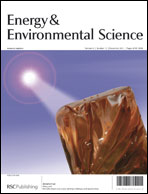Enzymatic biofuel cells have attracted much attention for their potential to directly use biochemical energy sources in living organisms such as animals, fruits, etc. However, generally natural organisms have a skin, and the oxygen concentration in the organisms is lower than that of biofuels like sugars. Here, we fabricated a novel miniature assembly that consists of a needle bioanode for accessing biofuels in organisms through their skins and a gas-diffusion biocathode for utilizing the abundant oxygen in air. The performance of the biocathode was fourfold improved by optimizing its hydrophobicity. The assembled device with four needle anodes for fructose oxidation was inserted into a raw grape, producing a maximum power of 26.5 μW (115 μW cm−2) at 0.34 V. A light-emitting diode (LED) with the cell served as a self-powered indicator of the sugar level in the grape. Power generation from blood sugar was also investigated by inserting a needle anode for glucose oxidation into a blood vessel in a rabbit ear. Prior coating of the tip of the needle anode with an anti-biofouling agent was effective to stabilize the output power.

You have access to this article
 Please wait while we load your content...
Something went wrong. Try again?
Please wait while we load your content...
Something went wrong. Try again?


 Please wait while we load your content...
Please wait while we load your content...